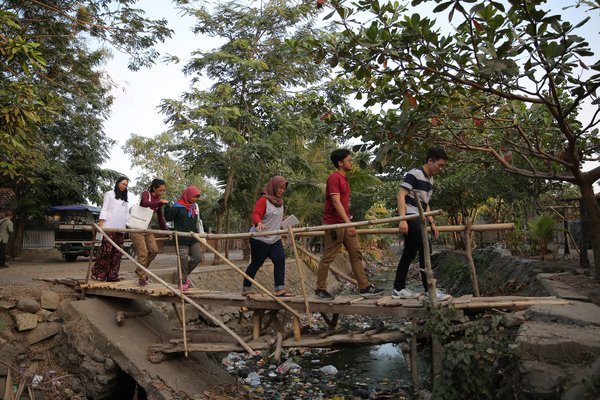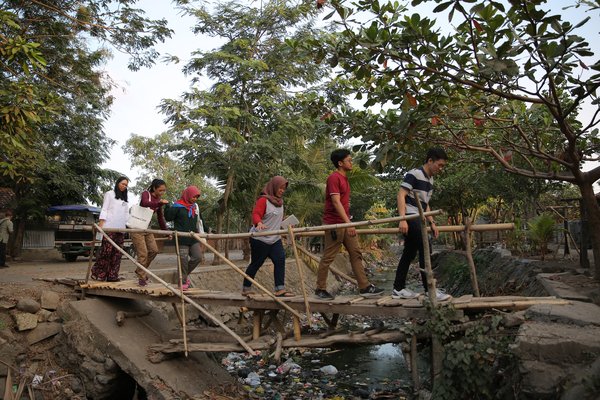JAKARTA, Indonesia, Oct. 9, 2018 /PRNewswire/ — According to the report of BNPB (National Disaster Management Agency), the number of death toll because of recent earthquakes and tsunami in Central Sulawesi has reached 1,424 people. That number consists of 1,203 death tolls in Palu, 144 death tolls in Donggala, 64 death tolls in Sigi, 12 death tolls in Parigi Moutong, and 1 death toll in Pasangkayu. The death toll reached 3 times more than that in recent Lombok’s earthquakes. BNPB report on October 5th showed the death toll has reached 1,558 people and will rise sharply due to high number of victims who have not been evacuated from the ruins of building or who were trapped in the mud.
The areas affected by the earthquake and tsunami disaster in Palu were more than 350 ha, of which those officially released by BNPB and Lapan were 180 ha in Petobo, 202 ha in Jono Oge, and 47.8 ha in Balaroa. The current situation of the three regions concerns the world since those residential areas considered ‘lost’ due to the earthquake and tsunami mud sweep. The breadth of the area damaged by the disaster caused the affected victims escaping to other areas, such as Mamuju Regency. Recorded up until October 5th 2018, Mamuju Regency received 4,257 refugees.
The damaged facilities and infrastructures due to the disaster’s devastation in Central Sulawesi made it hard to access electricity, clean water, sanitation, food, and other basic life needs, as well as the proper refugee camps. Those conditions might lead to the spreading of infectious diseases. Various studies about diseases caused by natural disasters indicate that the diseases’ clinical phase, which number of diseases are spreading high in a disaster, is at the disaster’s post-impact phase and recovery phase.
Basically, a disaster has 3 phases, namely the impact phase (1-4 days), the post-impact phase (4 days to 1 month), and the recovery phase (more than 1 month). In the post-impact phase, infectious diseases that are easy to spread are diseases caused by air, water and food. Those spreading supported by the bad condition of refugees’ camp. Meanwhile, during the disaster recovery phase, infections with a long incubation period begin to appear its clinical symptoms. In this phase, diseases which become endemic in an area could become epidemics due to displacement of refugees from one region to another.
According to various studies, diarrheal diseases account for as much as 40% of deaths at disaster sites and evacuation sites. The spread of diarrhea is related to contaminated water sources, water contamination during transportation and storage, use of shared cooking utensils, lack of soap, and contaminated food. In the 2004 Aceh tsunami, 85% of refugees in Calang City experienced diarrhea after drinking water from contaminated wells (Brennan & Kimba, 2006).
The study of Isidore et al (2014), a literature study from various post-disaster disease case report studies, shows that other infectious diseases which also infect refugees are leptospirosis, cholera, hepatitis A and E, acute respiratory infections, measles, meningitis, TB, malaria, dengue fever, tetanus, and Cutaneous mucormycosis fungal infection. The spread of influenza diseases such as H1N1 or commonly known as swine flu was also noted to develop very quickly with high mortality just after the devastating earthquake that shook East Japan in 2011.
Acute respiratory infection was the most common diseases causing deaths among refugees in Banda Aceh due to the 2004 tsunami. The risk of acute respiratory infections would increase in consequences of overcrowded conditions, poor ventilation, poor nutrition and cold weather. In addition, measles and meningitis were also reported to infect many refugees in Banda Aceh. Overcrowding refugees camp, poor hygiene, and difficult access to health care facilities and staying close to infected people are the main risk factors associated with the spread of these two diseases. The spread of tetanus was also reported to occur during the post-impact and recovery phases in Aceh tsunami. The spread was caused by open wound infections and populations who are not well-vaccinated.
Beyond the high number of death toll and the destruction of more than 65,000 buildings, the earthquake and tsunami that occurred in Central Sulawesi also affected fisheries, agriculture and livestock. Animals that die from disasters would increase the risk of zoonotic diseases exposure in human, such as anthrax, rabies, leptospirosis and others. In the same study, Isidore et al also noted that there were leptospirosis outbreaks in several disasters which occurred around the world, such as storms in Taiwan and China, and floods in Thailand and India.
General Directorate of Infection Prevention and Control, Ministry of Health Republic of Indonesia dr. Anung Sugiantono stated that Palu, Donggala and regions around them are malaria endemic areas. Environmental changes after the earthquake and tsunami will facilitate the spread of diseases carried by the Anopheles mosquito. For this reason, One Health approach is needed to prevent the expansion of malaria endemic in Palu and its surroundings.
One Health is a collaborative effort of multi-professions and health institutions which work locally, nationally and globally in achieving optimal health through the prevention and mitigation of adverse impacts due to animal, human and environmental interactions. This means that doctors, veterinarians, nurses, pharmacists, dentists, epidemiologists, and health institutions and other related institutions collaborate in addressing health issues. The One Health approach considers the role of changing environment with regard to the risk of infectious and chronic diseases affecting humans and animals.
Based on the situation, Prof. Wiku Adisasmito as INDOHUN (Indonesia One Health University Network) coordinator conveyed the importance of implementing One Health concept as an effective effort which could be applied in preventing the spread of post-disaster infectious diseases. “One Health concept developed by multi-disciplinary science and integrated cross-sector could prevent outbreaks of post-disaster diseases, especially the transmission of diseases between humans, animals and the environment.”
The step which should be taken by the government is establishing coordination between local city/regency offices and provincial agencies, also with the national level agencies to produce a comprehensive handling strategy. One example of a program which could be accomplished with multi-sectoral cooperation is a refugee shelter program that meets the standards.
Refugee shelter such as tents or barracks should be in proper condition, thus it would not increase the number of deaths caused by infectious diseases. The proper conditions for refugees’ camp are indicated by the availability of clean water and adequate sanitation facilities, as well as sufficient food. Health workers or volunteers are also expected to fulfill the qualifications in order to provide the best care supported by adequate amounts and types of drugs. Minimum standards of health services in refugees camp according to the Ministry of Health are public health services, reproductive health services, and mental health services. Prevention and eradication of infectious diseases also need to be done by conducting surveillance, vaccination, and case management of disease.



